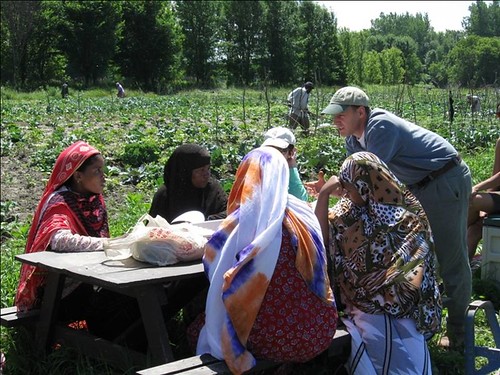
What does USDA have to do with supporting refugees? What do refugees contribute to our food systems here in the United States? The answers become clear when you look at a unique partnership between the U.S. Department of Health and Human Services’ Refugee Agricultural Partnership Program (RAPP), USDA, and Agricultural Extension agents. RAPP helps refugee farmers earn viable incomes through agriculture, by providing grants to support organizations and training in topics like business practices, pest control, land financing, and selling to restaurants and farmers markets.
In recent years, RAPP has provided services to refugees resettling from countries in Africa and Southeast Asia who often have agrarian backgrounds. In many cases, these individuals come to the United States with a wealth of agricultural knowledge that would go to waste if they didn’t have an opportunity to engage in gardening or farming. At the same time, there are areas that lack access to fresh and healthy food, often called “food deserts,” and refugee farmers can and do play an important role in making affordable produce available within these food deserts.
Somali Bantu farmers at Intervale Center in Vermont In San Diego, New Roots Community Farm has given refugees from Burma and Somalia an opportunity to farm and find economic security through doing so. They grow their familiar crops along with crops that are already popular here in the United States. For example, the Karen, an ethnic minority from Burma, grow and eat a variety of crops that include roselle, elephant ears, and water spinach, which they sell at their local farmers market.
New Roots Community Farm, a project of International Rescue Committee, received RAPP funding to hire staff and buy supplies like hoes, shovels, and seeds. The farm has since expanded its operations to reach more farmers and has been recognized by the California Endowment, Centers for Disease Control and others for outstanding work connecting agriculture to food, nutrition, and health. Their impressive work was noted by First Lady Michelle Obama, who visited it in April 2010 as part of the Let’s Move initiative.
Hmong farmers market stand in Fresno, California Equally important to providing land can be technical assistance. Cooperative Extension Agent Richard Molinar of the University of California’s Small Farm Program has found that many refugee farmers have difficulty accessing key resources necessary to run their operations, including access to credit, business development, marketing, and risk management. These difficulties stem from the fact that many refugee farmers have little time to attend informational meetings or, in some cases, because they face literacy and language obstacles to obtaining resources. With fellow Extension agent Michael Yang, Richard links would-be farmers with landowners and provides farm planning classes in various languages and creative formats like a late-night Hmong radio show. Along with local USDA field staff, he’s helped develop important educational tools for refugee farmers, including a comprehensive 2007 Small Farm Resource Directory, a training resource guide in Hmong and English, and detailed costs of production and marketing of specialty niche crops. USDA’s National Institute of Food and Agriculture is a Federal partner with Cooperative Extension agents nationwide. Find your local extension agent using this map.
The results of the RAPP partnership, which includes USDA’s agricultural programs, touch the lives of refugee farmers and their neighbors, alike. Because of RAPP, refugee farmers can access a steady income, familiar foods, better physical and mental health, and a smoother integration into American society – as business owners, farmers, neighbors, and friends.
